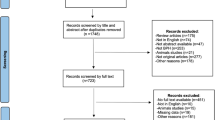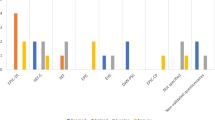Abstract
The objective of this work is to describe the profile of prevalent and incident populations suffering from lower urinary tract symptoms (LUTS) suggestive of benign prostatic obstruction (BPO) and to analyse the management of care by 620 general practitioners (GPs) in France in 1997 and 1998. Patient records were extracted from the THALES database. Special attention was given to the use of medical therapy and switch rates (ie change to another or combination with another drug). In real life practice (RLP) French GPs predominantly utilise α1-adrenoceptor antagonists for the treatment of LUTS. This is in agreement with available evidence from randomised controlled trials (RCTs) with different medical therapies (α1-adrenoceptor antagonists, finasteride, plant extracts). On the contrary, the relatively high usage of phytotherapy might be explained by traditional and personal preferences. Using purely descriptive statistics, newer α1-adrenoceptor antagonists, alfuzosin and tamsulosin, seem to be the most frequently prescribed medical therapy for new patients and are, moreover, associated with a low switch rate.
This is a preview of subscription content, access via your institution
Access options
Subscribe to this journal
Receive 4 print issues and online access
$259.00 per year
only $64.75 per issue
Buy this article
- Purchase on Springer Link
- Instant access to full article PDF
Prices may be subject to local taxes which are calculated during checkout
Similar content being viewed by others
References
Sagnier P-P et al Results of an epidemiological survey using a modified American Urological Association symptom index for benign prostatic hyperplasia in France. J Urol 1994 151 1266–1270.
Chapple CR. Pharmacotherapy for benign prostatic hyperplasia—the potential for α-adrenoceptor subtype-specific blockade. Br J Urol 1998 81 (Suppl 1): 34–47.
Boyle P, Gould AL, Roehrborn CG. Prostate volume predicts outcome of treatment of benign prostatic hyperplasia with finasteride: meta-analysis of randomized clinical trials. Urology 1996 48 398–405.
Lepor H et al The efficacy of terazosin finasteride, or both in benign prostatic hyperplasia. New Engl J Med 1996 335 533–539.
Debruyne FMJ et al Sustained-release alfuzosin, finasteride and the combination of both in the treatment of benign prostatic hyperplasia. Eur Urol 1998 34 169–175.
Kirby R et al Results of the PREDICT (Prospective European Doxazosin and Combination Therapy) trial. J Urol 1999 161 (Suppl): 266 (abs. 1027).
Lepor H et al. The impact of medical therapy on bother due to symptoms, quality of life and global outcome, and factors predicting response. J Urol 1998 160 1358–1367.
Berges RR et al. Randomised, placebo-controlled, double-blind clinical trial of β-sitosterol in patients with benign prostatic hyperplasia. Lancet 1995 345 1529–1532.
Klippel KF, Hiltl DM, Schipp B. A multicentric, placebocontrolled, double-blind clinical trial of β-sitosterol (phytosterol) for the treatment of benign prostatic hyperplasia. Br J Urol 1997 80 427–432.
Carraro J-C et al. Comparison of phytotherapy (Permixon®) with finasteride in the treatment of benign prostate hyperplasia: a randomized international study of 1098 patients. Prostate 1996 29 241–242.
Denis LJ. Editorial review of `comparison of phytotherapy (Permixon®) with finasteride in the treatment of benign prostate hyperplasia: a randomized international study of 1098 patients'. Prostate 1996 29 241–242.
Djavan B, Marberger M. A meta-analysis on the efficacy and tolerability of α-adrenoceptor antagonists in patients with lower urinary tract symptoms suggestive of benign prostatic obstruction. Eur Urol 1999 36 1–13.
Holtgrewe HL et al. The economics of the management of lower urinary tract symptoms and benign prostatic hyperplasia. In: Denis L et al (eds). Proceedings of the 4th International Consultation on BPH. Plymbridge Distributors Ltd: Plymouth 1998 63–81.
Lukacs B. Management of symptomatic BPH in France: who is treated and how? Eur Urol 1999 36 (Suppl 3): 14–20.
Coffey DS. Controversies in the management of lower urinary tract symptoms: an overview. Br J Urol 1998 81 (Suppl 1): 1–5.
Journal Officiel de la République Française. 1995 5 mars 3493–3504. Arrêté du 3 mars 1995. Références médicales opposables. Thème XXI:3500–1.
Denis L et al. Recommendations of the International Scientific Committee: the evaluation and treatment of lower urinary tract symptoms (LUTS) suggestive of benign prostatic obstruction. In: Denis L et al (eds). Proceedings of the 4th International Consultation on BPH. Plymbridge Distributors Ltd: Plymouth 1998 669–684.
Farmer RDT et al. Changes in the patterns of management of benign prostatic hyperplasia in the United Kingdom: 1991–1998. Eur Urol 2000 37 (Suppl 2): 118 (abstract 471).
Dreikorn K et al. Other medical therapies. In: Denis L et al (eds). Proceedings of the 4th International Consultation on BPH. Plymbridge Distributors Ltd: Plymouth 1998 633–659.
Abbou CC et al. Alfuzosin, an uroselective alpha 1 blocker versus Pygeum africanum, a plant extract: a randomized controlled trial in patients with symptomatic benign prostatic hypertrophy (BPH). Eur Urol 1996 30 (Suppl 2): 77 (abstract 241).
Grasso M et al. Comparative effects of alfuzosin versus Serenoa repens in the treatment of symptomatic benign prostatic hyperplasia. Arch Esp Urol 1995 48 97–103.
Andersen JT et al. Finasteride significantly reduces acute urinary retention and need for surgery in patients with symptomatic benign prostatic hyperplasia. Urology 1997 49 839–845.
McConnell JD et al. The effect of finasteride on the risk of acute urinary retention and the need for surgical treatment among men with benign prostatic hyperplasia. New Engl J Med 1998 338 557–563.
Abrams P et al. Tamsulosin, a selective α1C-adrenoceptor antagonist: a randomized, controlled trial in patients with benign prostatic ‘obstruction’ (symptomatic BPH). Br J Urol 1995 76 325–336.
Chapple CR et al. Tamsulosin, the first prostate-selective α1A-adrenoceptor antagonist. A meta-analysis of two randomized, placebo-controlled, multicentre studies in patients with benign prostatic obstruction (symptomatic BPH). Eur Urol 1996 29 155–167.
Lepor H. Long-term evaluation of tamsulosin in benign prostatic hyperplasia: placebo-controlled, double-blind extension of phase III trial. Urology 1998 51 901–906.
Michel MC et al. Tamsulosin treatment of 19,365 patients with lower urinary tract symptoms: does co-morbidity alter tolerability? J Urol 1998 160 784–791.
Buzelin JM et al, for the European Tamsulosin Study Group. Comparison of tamsulosin with alfuzosin in the treatment of patients with lower urinary tract symptoms suggestive of bladder outlet obstruction (symptomatic benign prostatic hyperplasia). Br J Urol 1997 80 597–605.
Lee E, Lee C. Clinical comparison of selective and non-selective α1A-adrenoceptor antagonists in benign prostatic hyperplasia: studies on tamsulosin in a fixed dose and terazosin in increasing doses. Br J Urol 1997 80 606–611.
Na YJ, Guo YL, Gu F-L and the Chinese Tamsulosin Study Group. Clinical comparison of selective and non-selective alpha1A-adrenoceptor antagonists for bladder outlet obstruction associated with benign prostatic hyperplasia: studies on tamsulosin and terazosin in Chinese patients. J Med 1998 29 289–303.
De Mey C, Michel MC, McEwen J, Moreland T. A double-blind comparison of terazosin and tamsulosin on their differential effects on ambulatory blood pressure and nocturnal orthostatic stress testing. Eur Urol 1998 33 481–488.
Stoevelaar HJ et al. Treatment choice for benign prostatic hyperplasia: a matter of urologist preference? J Urol 1999 161 133–138.
Acknowledgements
We would like to express our gratitude to Ismar Healthcare NV (Belgium) for their support in the editing of this manuscript.
Author information
Authors and Affiliations
Corresponding author
Rights and permissions
About this article
Cite this article
Vallancien, G., Pariente, P. Treatment of lower urinary tract symptoms suggestive of benign prostatic obstruction in real life practice in France. Prostate Cancer Prostatic Dis 4, 124–131 (2001). https://doi.org/10.1038/sj.pcan.4500517
Received:
Revised:
Accepted:
Published:
Issue Date:
DOI: https://doi.org/10.1038/sj.pcan.4500517
Keywords
This article is cited by
-
Quality of life in patients with lower urinary tract symptoms associated with BPH: change over time in real-life practice according to treatment—the QUALIPROST study
International Urology and Nephrology (2016)
-
The effectiveness of a scientific symposium to change urologists’ attitude towards treatment of LUTS/BPH
International Urology and Nephrology (2007)
-
Not all brands are created equal: a comparison of selected components of different brands of Serenoa repens extract
Prostate Cancer and Prostatic Diseases (2004)



